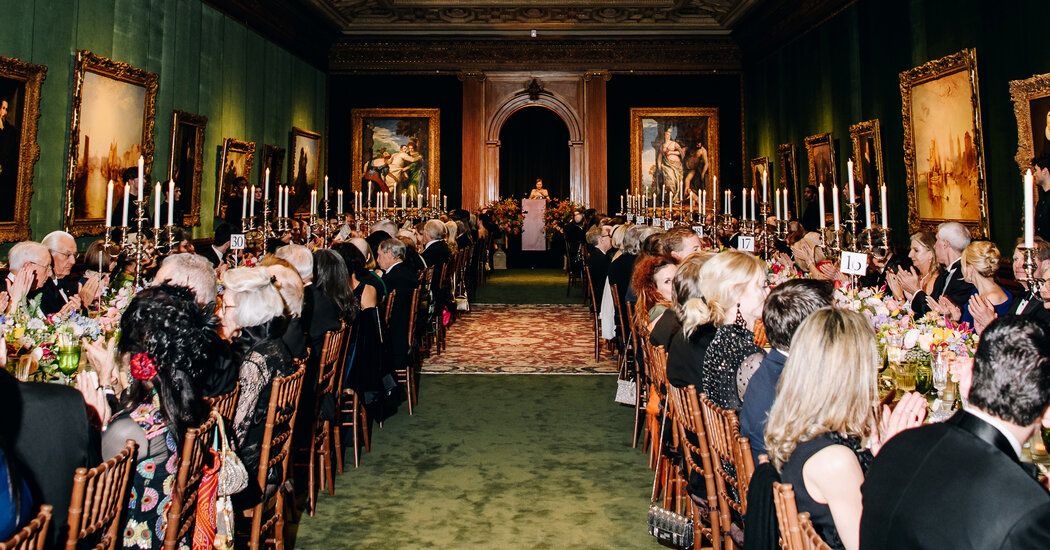On a rainy night on the Upper East Side, art world philanthropists, billionaire business moguls and New York socialites scurried under a canopy of umbrellas and into the newly restored Frick.
Old money — the Gilded Age mansion of the industrialist Henry Clay Frick — met new money — a $220 million renovation — on Monday night at the Frick Collection’s long-awaited opening gala, where swooping capes and cheek-to-cheek kisses were en vogue among the Vermeers, Van Dycks and Rembrandts.
Once partygoers had dried off inside — past a marble bust of Mr. Frick himself — they popped caviar tater tots over flutes of champagne and took in the mansion’s refreshed environs, which are set to open to the public on April 17.
“It’s really important to have spaces where we can leave politics at the door and find common interests in something like art and beauty,” said Tai-Heng Cheng, a lawyer, legal scholar and Frick trustee who wore his great-great-grandfather’s pendant.
“And we can bicker endlessly about what’s beautiful, but that’s OK,” he added. “That’s better than bickering endlessly about other more weighty things.”
In pleated gowns and black tuxedos, couples proudly ascended the grand staircase to the newly added second floor.
In the Gold Grounds room upstairs, Ian Wardropper, the museum’s former director, who recently retired, explained the origin of a cluster of porcelain flowers to Jo Carole and Ronald Lauder (as in Estée).
As he spoke, Mr. Wardropper was interrupted and complimented several times for his vision and persistence. During his 14-year-tenure, he considered six proposals for the museum’s renovation, but he held on to see Annabelle Selldorf’s lauded expansion through.
Tijana Ibrahimovic, a media personality, said she was thrilled to visit the new section for ceramics, as well as to experience the “old-world feel” of the library. But there was one feature that particularly captivated her. “I’m excited to see the fountain in the middle again,” she said.
Guests marveled at the marble steps, original to the mansion, and their natural path to “the Piero”: Piero della Francesca’s 15th-century showstopper Saint John the Evangelist, cloaked in red, feet bare, with a cherry-on-top golden halo.
“What a sightline,” Mr. Wardropper said, taking brief moment to sit on a plush hexagonal bench in a former bedroom, now a homage to Mr. Frick’s daughter Helen Clay Frick. Until the renovation, it had been used by museum staff.
“Seeing people walk through is such a pleasure,” he added.
Spectators admired the curtains (weighty, handwoven drapery replete with thick tassels, coils and sateen balls), took iPhone photos in front of classic works (Manet’s “Bullfight” was of particular interest) and gazed upon works by Rousseau and Millet until being whisked away for dinner downstairs.
Those seated in the West Gallery, the grand hall that is “as long and wide as an airport runway, custom-built for art,” the critic Holland Cotter wrote for The New York Times in a visual guide to the reopening, were treated to opening remarks from Elizabeth “Betty” Eveillard, the chair of the Frick’s board of trustees.
But a majority of the guests were scattered in gallery rooms across the first floor, where they watched the remarks via livestream on TVs stationed in each room.
Ms. Eveillard announced the board’s naming of the newly built Ian Wardropper Education Room, in honor of Mr. Wardropper’s pursuit to expand educational programming.
And the gala, she noted, looking down the long banquet tables set with candelabras, their candles flickering with faux flames (why risk burning down millions of dollars’ worth of renovations?) sold out before invitations were even in the mail. The event, which was attended by more than 450 people, raised $3.7 million.
“I thank you all,” she said. “And I say, welcome home.”
The Fragonard Room became a kind of kids table — or cool kids’ table — where younger patrons, including the model Ivy Getty and the Vogue editor Lilah Ramzi, gabbed and dined on avocado crab salad while surrounded by paintings of floating cherubs and ethereal children.
“We’re giving gay Gilded Age for the Frick,” the theater producer Jordan Roth said, exhibiting the components of his puffy-sleeved, all-black look. “Vintage Dior, vintage Lanvin, two-days-ago Prada.”
“Fresh paint!” the socialite Laurence Milstein chimed in, referring to Mr. Roth’s new Prada. “I was like, you know what, if there’s one person who’s going to understand the assignment, it’s Jordan Roth.”
In between courses, attendees took to the Garden Court and sipped cocktails around the fountain, under the gold hues of the stately, illuminated columns.
After a main course of roasted mallard duck with pickled blackberry port jus, it was time for final remarks. Axel Rüger, the museum’s director, presented Mr. Wardropper, his predecessor, with a commemorative silver tray from Christofle.
“My tuxedo and I have been in a race to see who would retire first,” Mr. Wardropper said.
The evening, he continued, was a celebration of “bringing the Frick into the 21st century.” It was the culmination, he added, of transforming a mansion that once had a team of 30 servants serving three people, into a museum and education center serving 300,000 people.
“Long live the Frick!” Mr. Wardropper concluded, and everyone in the room, flanked by two Turners on velvet-coated green walls, leaped to their feet and applauded.
Suddenly, a stampede of waiters emerged ferrying miniature shipping crates made of chocolate, adorned with “fragile” stickers and accompanied by little golden mallets.
With puzzled — and then delighted — looks, guests cracked into their desserts, shattering the packages to reveal Frick masterpieces in cookie form — making collectors out of all who attended.
